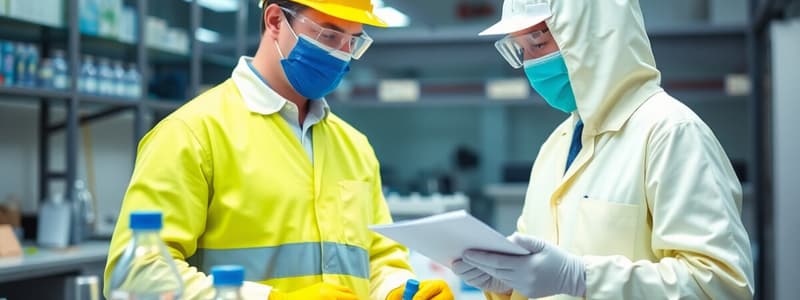Podcast
Questions and Answers
What role does a safety officer play in a laboratory setting?
What role does a safety officer play in a laboratory setting?
A safety officer assists in identifying potential risks and helps incorporate preventive measures to ensure laboratory safety.
Why is it important to maintain records of staff exposures to hazards?
Why is it important to maintain records of staff exposures to hazards?
Maintaining records is essential to track incidents, assess risks, and develop procedures to prevent future occurrences of exposure.
Discuss the significance of safety training for laboratory equipment.
Discuss the significance of safety training for laboratory equipment.
Safety training is vital to ensure laboratory staff know how to operate equipment safely and prevent injuries from hazards like electrical shock or radiation.
What precautions must be taken for the storage of compressed gas cylinders?
What precautions must be taken for the storage of compressed gas cylinders?
Explain the risks involved with laboratory sharps and how they should be disposed of.
Explain the risks involved with laboratory sharps and how they should be disposed of.
How does physical risk assessment contribute to laboratory safety?
How does physical risk assessment contribute to laboratory safety?
What additional health risks are mentioned beyond physical risks?
What additional health risks are mentioned beyond physical risks?
What is a recommended technique for recapping needles safely?
What is a recommended technique for recapping needles safely?
What is the maximum weight a cardboard box used for laboratory glass disposal should not exceed?
What is the maximum weight a cardboard box used for laboratory glass disposal should not exceed?
What color or wording should be prominent on a sharps container?
What color or wording should be prominent on a sharps container?
List one of the three main routes through which chemicals can enter the body.
List one of the three main routes through which chemicals can enter the body.
What specific type of chemical storage area is required for radioactive materials?
What specific type of chemical storage area is required for radioactive materials?
What should be done with contaminated laboratory glass before disposal?
What should be done with contaminated laboratory glass before disposal?
What document provides detailed hazard and precautionary information about chemicals?
What document provides detailed hazard and precautionary information about chemicals?
What is a major source of contamination in diagnostic laboratories?
What is a major source of contamination in diagnostic laboratories?
Why should chemicals be labeled with their common names and concentrations?
Why should chemicals be labeled with their common names and concentrations?
What type of materials should never be disposed of in cardboard boxes?
What type of materials should never be disposed of in cardboard boxes?
What is the recommended action in the event of a chemical leak or spill according to the MSDS?
What is the recommended action in the event of a chemical leak or spill according to the MSDS?
Flashcards are hidden until you start studying
Study Notes
Risk Identification in Laboratories
- Laboratory workers face numerous risks varying by activity and analysis type.
- Risk assessment is essential for laboratory directors to safeguard employee safety.
- Collaboration with safety officers helps identify potential risks and establish preventive measures.
- Development of safety procedures for accidents, injuries, or contamination is vital.
- Maintain detailed records of staff exposures to hazards and actions taken to mitigate future risks.
- Study from Howard Hughes Medical Institute highlighted physical risks but noted ongoing contamination and infection risks, including SARS-related laboratory-acquired infections.
Equipment and Safety Training
- Laboratory equipment poses significant injury risks, necessitating specific safety training.
- Key equipment requiring safety precautions includes autoclaves, centrifuges, compressed gas cylinders, and fume hoods.
- Risks of electrical shock, microwave, or radiation exposure exist with improper use or maintenance of instruments.
- Compressed gas storage requires unique precautions; cylinders must be secured and safety caps used when moving.
Handling and Disposal of Sharps
- Proper handling and disposal of needles, broken glass, and sharps prevent infection risks.
- Avoid needle recapping; if necessary, use a specific technique for safety.
- Dispose of sharps in puncture-resistant containers labeled "SHARPS."
- Non-biohazardous sharps containers must have BIOHAZARD markings defaced before sealing.
- Laboratory glass must be transported in sturdy boxes, with contaminated glass decontaminated prior to disposal.
Chemical Exposure Risks
- Toxic chemical exposure can occur via inhalation, skin absorption, and ingestion.
- Inhalation is the primary route, particularly for solvents; rapid absorption poses serious risks.
- Skin condition affects absorption rates; systemic poisoning can result from exposure.
- Accidental ingestion often stems from poor laboratory hygiene.
- Chemical labels must include common names, concentrations, hazards, and dates of receipt/opening/expiration.
- Store hazardous chemicals properly: corrosive and toxic ones in ventilated areas and flammables in secure cabinets.
Storage and Handling of Radioactive Materials
- Radiochemicals demand special precautions and dedicated benches for use.
- Radioactive materials require specific storage areas with materials like plexiglass or lead for protection.
Material Safety Data Sheets (MSDS)
- MSDS provide essential safety and hazard information for chemicals.
- Information includes product details, fire/explosion risks, toxicology, PPE recommendations, and waste disposal guidelines.
- MSDS must be accessible to employees and placed near hazardous materials usage areas.
Containment Systems in Laboratories
- Laboratory-acquired infections, primarily from aerosols, are common in diagnostic settings.
- Containment systems aim to prevent aerosol diffusion within and outside laboratories.
- Level 2 containment laboratories must have proper ventilation, while higher levels require continuous inward airflow and air filtration.
Studying That Suits You
Use AI to generate personalized quizzes and flashcards to suit your learning preferences.




